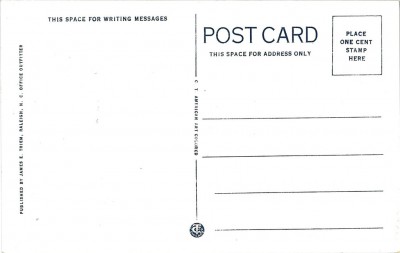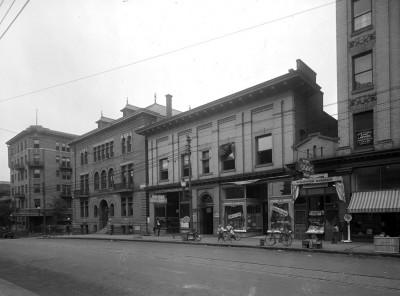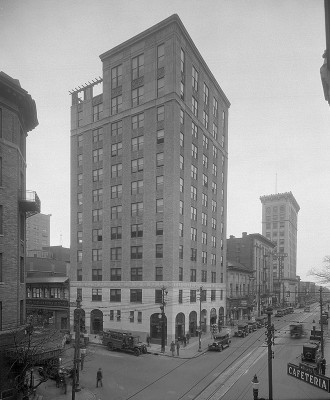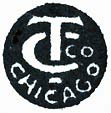Capital Club Building, Raleigh, N.C.
Our Flashback Friday postcard this week depicts downtown Raleigh’s familiar Art Deco-styled landmark, the Capital Club Building. The 12-story skyscraper has occupied the corner of Martin and Salisbury Streets since 1930.
The Capital Club was chartered in 1885 as a men’s club dedicated to “literary and social purposes.” In 1898, the club purchased a lot at the corner of Martin and Salisbury Streets, and hired the prolific regional architect Frank P. Milburn to design the original Capital Club building. Milburn had also designed a Chateauesque-styled dormitory for the state Deaf Dumb and Blind Institution on Caswell Square in 1898, and later the Professional Building at the corner of Hargett and McDowell Streets in 1925. Both of these structures survive to this day.
The photo below shows the Romanesque-inspired Capital Club (second from left) as it appeared in the 1920s. It stood as a landmark on the bustling cross-town Martin St. corridor between Union Station on Nash Square and City Market at Moore Square. Sadly, the elegant building was destroyed by fire in December 1927.
Capital Club members wasted no time in rebuilding, and commissioned Raleigh architect Frank B. Simpson (who happened to be a member of the Capital Club) to design a modern office building on the same site. Simpson’s many local commissions included Winston Hall on the NC State campus (1910) and the now-lost Art Deco Vance Apartments (1930) on Edenton St. He also worked as an associate architect with the renowned P. Thornton Marye on the state Administration Building (1913) and the Wake County Courthouse (1915).
The ‘New’ Capital Club
Completed in 1930, the steel-framed, 12-story building represented a transition between Commercial Neo-Classicism and Art Deco. It is one of the few Art Deco buildings remaining in Raleigh.
The photo below shows the Capital Club Building under construction in 1929.
After two years and a cost of $280,000, the Capital Club Building opened on November 14, 1930. The top three floors were used for the Capital Club: billiards room, four card rooms, gymnasium, locker rooms, and showers on the 10th; reading room, club lounge, men’s and women’s rest rooms on the 11th; and a combination dining and ballroom, service kitchen, and the tiled and trellised roof garden on the 12th.
— The Historic Capital Club Building
Here is how the Capital Club Building appeared in the early 1930s. The “tiled and trellised roof garden” can be seen in this photo. The space was later enclosed in the 1940s and converted to utilitarian purposes. In the background is another early Raleigh skyscraper, the Beaux Arts-styled Citizens National Bank.
The Historic Capital Club Building was renovated and modernized for office use in 1992. More recently, the popular restaurant Capital Club 16 has moved into the street floor level, and the elegant 12th floor “Grand Ballroom” has been fully restored to its Art Deco grandeur.
 Seen above is a detail of the Art Deco styling of the Grand Ballroom.
The Capital Club Building is listed on the National Register of Historic Places.
This week’s ‘white border’ postcard was published by long-time Raleigh stationer James Thiem, and was produced by the renowned Chicago postcard printer Curt Teich Co.
Curt Teich Co.  1893-1974
Chicago, ILA major publisher and printer. Their U.S. factories turned out more cards in quantity than any other printer. They published a wide range of national view-cards of America and Canada. Many consider them one of the finest producers of White Border Cards. The Linen Type postcard came about through their innovations as they pioneered the use of offset lithography. They were purchased by Regensteiner Publishers in 1974 which continued to print cards at the Chicago plant until 1978.
“Flashback Friday†is a weekly feature of Goodnight, Raleigh! in which we showcase vintage postcards depicting our historic capital city. We hope you enjoy this week end treat!








 Sign up for the Newsletter
Sign up for the Newsletter
11/17/2012
So does anyone use the Ballroom? is it open for functions?
11/21/2012
Anna Ball Hodge – Oh yes, the Grand Ballroom is a choice site available for all sorts of social activities. The spacious 12th floor ballroom can accommodate 150 guests. For details check out The Historic Capital Club Building website: http://www.grandballroomraleigh.com/#about
04/30/2014
It seems like there is some really interesting history here in between the heyday of the Capital Club in the 1930s (a reading room! a gym! a club lounge!) and the conversion to an office building in 1992. Would love to learn more about that era.